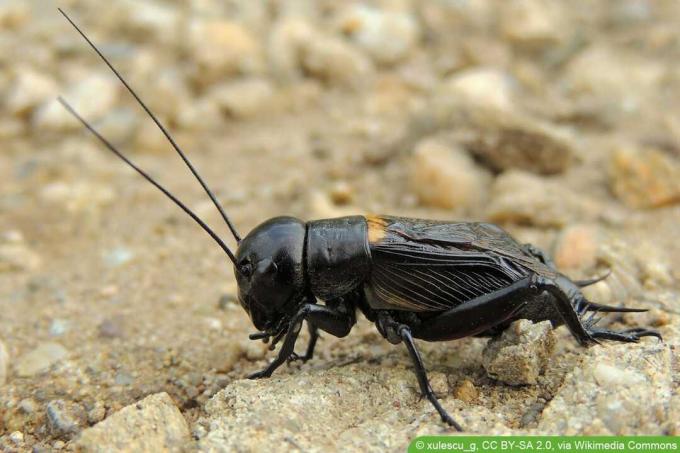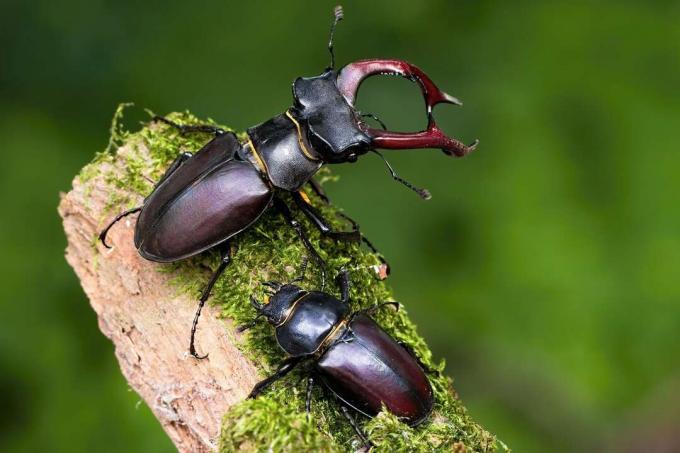

Table of contents
- Identify field crickets
- chirp
- Fight field crickets?
- What do field crickets eat?
- harmful effect
- Get rid of field crickets
- Prevent
- fun facts
In 2003, the field cricket was voted insect of the year. Their chirping can be heard less and less. In warm, dry summers, it occurs more frequently in places. How to fight them?
Identify field crickets
- botanical name: Gryllus campestris
- belongs to the cricket family
- Colour: black with wings marked in yellow
- strikingly large, round head
- Length: 20 to 26 millimeters
- Identifying feature: loud chirping
- very jumpy
- lives in burrows it has dug itself, preferably on dry and poor grassland
chirp
The conspicuous chirping of the male field cricket is caused by the rapid movement of the wings against each other. The music of the field crickets can be heard from May to July. Male crickets chirp so loudly that they can be heard within a radius of 50 meters. Female field crickets can also chirp. However, their singing is imperceptible to human hearing.
Fight field crickets?
The field crickets are on the red list of endangered species in Germany! Even if the impressive black insect occurs in greater numbers in southern Germany, its population is extremely threatened due to the decline in uncultivated, semi-natural green spaces. Anyone who notices a Gryllus campestris cricket in the garden should be happy. Their presence is a sign of a healthy biotope.
A notice:
The biggest enemies of the field cricket are intensive agriculture, the use of chemicals and the displacement of dry grassland in favor of new settlement areas.
What do field crickets eat?
Field crickets are omnivores. belong to their diet
- root
- Herbs
- leaves
- carcasses of insects
- small soil animals such as mites and beetles
Field crickets are on the menu of many native animals, e.g. B.
- birds
- reptiles
- mice
- foxes

Field crickets have little defense. Although their biting tools are sharp and powerful, they have no chance of defending themselves against birds, mice or larger animals. Field crickets have no sting and cannot spray poison. However, it is not easy for the enemies of the cricket. When danger threatens, the shy animals quickly disappear into their burrows.
harmful effect
Field crickets are not pests. In contrast to the almost insatiable appetite of locusts, the black insects' food requirements are very low, so there is no fear of damage caused by feeding in the garden. Field crickets dig holes in the lawn. However, the insects do not usually appear in large swarms, so these are only individual, small holes. The crickets are loners. Immediately after mating, males and females retire to their own burrows. Only the loud singing of the male crickets can be disturbing.
Get rid of field crickets
Field crickets love dry conditions. If field crickets bother you because of their loud singing, water your lawn thoroughly. The insects quickly look for a drier place.
Even the smallest noise drives the black field crickets out of their territory. After mowing the lawn, the residents usually disappear from their burrows and move to a quiet living space.
Tip:
Make your garden as natural as possible. Birds, lizards, hedgehogs and the like are happy when they occasionally catch a field cricket.
Prevent
Before a cricket enters your home and robs you of sleep with loud chirping, prevent its entry. Close the windows with insect screens and do not open the doors and windows of lighted rooms in the evening. Clean your home with vinegar cleaner. If you follow these precautions, crickets will stay outside.
fun facts
Did you know that crickets play a special role in superstitions? A cricket in the bakery should bring luck and good customers to the baker. On the other hand, the insects were seen as spirits of the dead. In Thuringia, the phrase "lazy as a cricket" is common.
 Home editorial office
Home editorial office
Learn more about insects

Identify beetles with pincers: 10 native species
Beetles are impressive insects. There are large and small, dark and dazzlingly colorful species. Some have pincer-like upper jaws for crushing or holding prey. The stag beetle is the largest among them. We present 10 native beetles with pincers.

Insect Hotel Filling: 10 filling materials
An insect hotel in your own garden offers numerous insects artificial shelter, nesting and wintering opportunities. They are more than necessary, because they are disappearing more and more as a result of massive human intervention in nature. They are essential for survival.

What do ladybugs eat and drink?
There isn't just one ladybug. Instead, there are several different species, not all of which eat aphids in the classic way. Some are even pure herbivores. Read here what else ladybugs like as food.

Insect species: which insects are there in Germany?
In Germany there are around 30,000 species of insects in various shapes and colours. Of these, there are some that are better known than others. In this article you will find a large list of native insects that shape the image of the country.

Spiders in Germany | Identify 18 species of spiders
Spiders cause disgust and disgust in many people. It often helps to take a closer look at these fascinating eight-legged creatures. Identify species that are common in Germany with us and learn about their appearance and habits.

46 bee-friendly plants by flowering season
With bee-friendly plants in the garden or on the balcony, wild bees and honey bees can make an important contribution. Both are threatened with extinction. In addition, you also support many other useful insects and birds.
